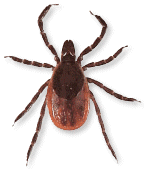By: Animal Hospital of Barrington
It’s a popular misconception that fleas and ticks are not a threat once we head into autumn and cooler weather. While we wish this were true as much as you do, unfortunately, it is not.
FLEAS While fleas are indeed more prevalent during warm summer months, they can survive as adults on hosts over the winter, even feeding on humans temporarily if their preferred host is not available. To understand why these pests are so hardy, it is important to understand their lifecycle.
Egg Stage
One female flea lays about 2,000 eggs in her lifetime – up to 50 eggs in just one day! The eggs quickly fall off your pet and into areas of your home. In 2 to 5 days, the eggs hatch.

Larval Stage
After hatching, the larvae head toward dark places (indoors this is most often deep in carpet fibers) and feed on “flea dirt” – excrement of the partially digested blood of your pet. The larvae grow, molt twice, and then spin cocoons, where they grow to pupae. They complete this process in only 5 to 11 days.
Pupal Stage
Insecticides are not very useful during the pupal stage because of the inaccessible location of the cocoons. During this phase, which lasts about 8 or 9 days, they continue to grow to adulthood, waiting for the signal that it is time to emerge. Physical pressure, carbon dioxide, and heat all stimulate hatching.
To make matters worse, fleas tend to emerge from their cocoons over a period of 2 to 4 weeks rather than all at once (a phenomenon called “the pupal window effect”), so populations tend to maximize. This is why new adults can continue to emerge for several months after an insecticide application has killed one adult population.
Adult Stage
Upon detecting heat, vibrations, and exhaled carbon dioxide from inside their cocoons, adult fleas know a host is nearby. The adults leave their cocoons, hop onto a host, find a mate, and begin the life cycle all over again.
Because it only takes one flea or one flea egg to start an entire population, we strongly suggest taking preventative measures all year long. While fleas may not be as active outside during the cold months, they are quite capable of surviving the winter indoors and by other means. If your dog plays with other neighborhood dogs, goes to doggy daycare, is kenneled, or attends classes of any kind, he is may be exposed to potential hosts carrying fleas. This is also true if your cat hunts or maybe encountering other cats in his travels outside.
Potential medical issues and diseases caused by fleas include tapeworms, Bubonic plague, Maurine Typhus, anemia, and a myriad of skin conditions.
TICKS
Egg Stage
Female ticks lay eggs in secluded areas where vegetation is dense and several inches high. Adult females of some tick species lay about 100 eggs at a time; others lay 3,000 to 6,000 eggs per batch. Regardless of species, tick eggs hatch in about 2 weeks.
Larval Stage
After hatching, the larvae move into grass or shrubs in search of their first blood meal. If you or your pet passes by, they attach themselves and crawl upward in pursuit of an area of the skin that they can feed from. After taking a blood meal, they drop off the host and back into the environment.

Nymphal Stage
After finding their first blood meal, the larvae molt into their nymph stage and begin searching for another host. Nymphs are small in size and often go undetected, increasing the chance for disease transmission.
Adult Stage
Once the nymph has had its blood meal, it matures into adulthood. Adult female ticks feed on a host for 8 to 12 days. In some cases, they will increase to 100 times their original weight while feeding. While still on the host, the female will mate, fall off and lay her eggs in a secluded place – beginning the life cycle again.
A tick’s lifespan may be several years. They are also capable of surviving a wide range of temperatures and weather conditions and for these reasons, there are very few times of the year when they are not a threat. During winter thaws, it is not uncommon for us to get calls from clients who are shocked to find ticks on their pets.
Potential medical issues and diseases caused by ticks include Lyme Disease, Ehrlichiosis, Rocky Mountain spotted fever, and babesiosis in dogs. In cats, ticks can cause Feline Ehrlichiosis, Haemobartonellosis, Hepatozoonosis, and Hytauxzoonosis. Tick tick-borne encephalitis and Tick Paralysis can also be caused in any vertebrate host.
So that now you know that these pesky critters are important to prevent, how do you do it? Well, that’s where we come in! We are happy to help you select a preventative protocol tailored to your individual pet’s needs and risk factors. If you already have a flea infestation, we can help you tackle it with a combination of pet and home treatment. Please give us a call!7
